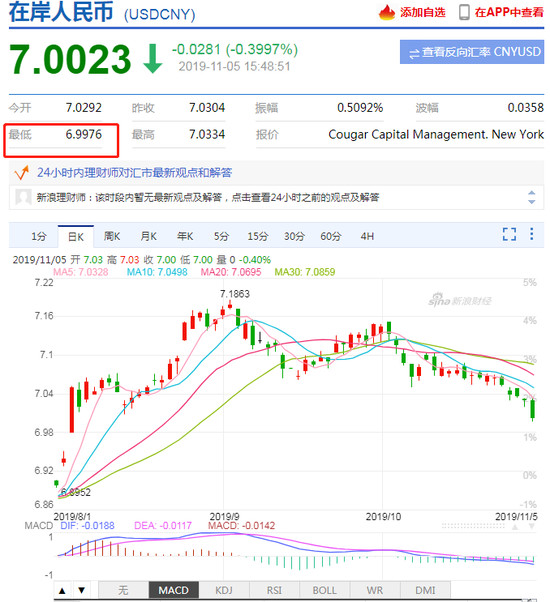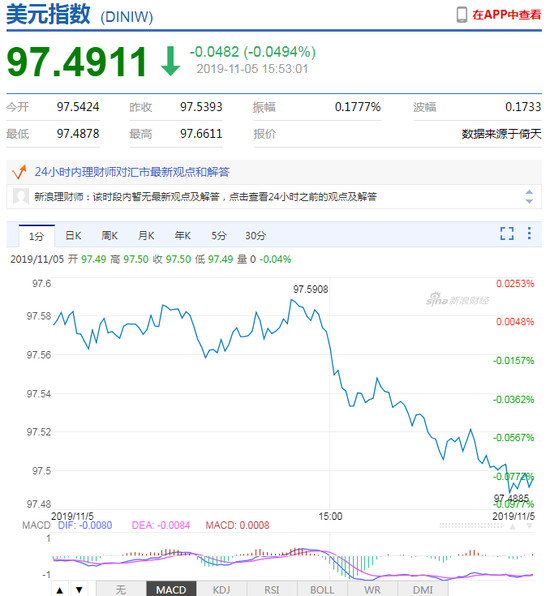
2019-11-06 13:37:12 Source:GLGA Author:GLGA Research Institute
On November 5, the onshore RMB kept appreciating and ended at 7.00 per USD, a new high since August 5, with a daily appreciation of nearly 300 points. Before this, the offshore RMB appreciated and recovered to 7.00 per USD, marking the first time since August 13. By 16:30 on the day, the onshore RMB closed at 6.9975 against the USD, up 327 base points from the previous trading day, plunging beyond 7 per USD for the first time since August 5.
Before that, when RMB fell below 7 against USD, many institutions adjusted their full-year forecasts to 7.3-7.5. However, after October, RMB kept appreciating steadily and stabilized within 7-7.1. At present, although RMB has temporarily risen above 7 per USD, it is widely believed that it is greatly possible that RMB will remain range bound.
Today, after the PBC announced the latest rate cut, RMB also saw a major plus and got recovered three months later. According to the real-time data of China Foreign Exchange Trade System, the onshore RMB hit 7.0 per USD for the first time since August 5. Till the release of this news, the offshore RMB against USD went up to 375 points at 6.9967. The onshore RMB against USD was reported at 6.9959.

The US Dollar index continues to drop.

According to report, on November 5, the PBC issued RMB400 billion of one-year MLF (Medium-term Lending Facility) and cut down the OMO interest rate of this MLF from 3.30% to 3.25%. According to report, the one-year MLF has remained at 3.3% since April 2018 and is cut by only 5 base points. This "rate cut" represents a surprise to the market and shows China's prudence in launching loose monetary policy compared with the rash reduction by 25 base points of the US.
Goldman Sachs proposes USD neutral trading.
A strategist at Goldman Sachs said that as the FRB has possibly ended its defensive rate cut, it is time to establish a less defensive foreign exchange portfolio position that performs better as the global economy shows signs of stabilizing. They recommend to make USD-neutral emerging market currency arbitrage, or G-10 currency trading holding "deep value but sensitive to economic growth". Goldman Sachs now believes no strong reason for a broad decline in the USD.
A strategist at Goldman Sachs pointed out that the USD would depreciate if there are more signs of global growth recovery, possible reduction of the USD interest rate and a clearer future path for international trade. At the same time, Goldman Sachs recommends less INR to offshore RMB as it is cautious about the recent trade situation.
The rebound of RMB exchange rate gets stronger.
The central parity rate of RMB against the USD hit a new high in nearly two and a half months. An analyst pointed out that the rebound of RMB exchange rate gets stronger and the expectation of falling has converged significantly, bringing universal benefits to RMB assets. According to historical data, the exchange rate of the local currency of most countries moves in the same direction as that of the stock market and the stabilization and rebound of the exchange rate is good for A shares and is expected to stimulate foreign investment in China's bonds.
The "best days" of the USD seem to have come to an end. This year, the USD outperformed expectations and brings greater pressure on the trend of the RMB exchange rate. The strong performance of the USD this year is mainly accountable to the following three reasons. First, the US shows an obvious intention of economic expansion. Second, the FRB remains slow in easing the monetary policy. Third, changes in the trade environment, coupled with geopolitical factors, drive hedging of USD assets. However, at present, the USD sees its strong foundation waver. Specifically, there are an increasing number of signs of weakening US economy and the economic differences between Europe and the US are narrowing. After the rate cut, the FRB restarts asset purchase and picks up pace in easing the monetary policy. The risk of Britain's "hard Brexit" declines, and European currencies rebounds sharply.
RMB assets gains universal benefits, especially appreciation benefitting shares.
From the perspective of marginal change, the risk of devaluation of RMB exchange rate is decreasing, and even certain appreciation is anticipated, bringing universal benefits to RMB assets.
In terms of the stock market, a research report of Orient Securities pointed out that based on historical data of many countries, the exchange rate of the local currency of most countries moves in the same direction as that of the stock market. That is, when the exchange rate depreciates, the stock price falls, and vice versa. In principle, either the exchange rate or the stock price is the "barometer" of the real economy and rising exchange rate is helpful to attract foreign capital.
On 4, the rise of the share price of listed companies in aviation, tourism, papermaking and other sectors led the A-share market and some traditional shares benefitting from RMB appreciation are ready to move.
According to experts, there are two main types of exchange rate fluctuations affecting corporate exchange gains and losses. One is to produce exchange gain or loss through directly influencing the closing value of assets or liabilities held by the company. The other is to indirectly generate exchange gain or loss by influencing the price of products or raw materials, and then the sales volume or cost. The appreciation of the local currency will be good for enterprises with a large amount of foreign debts, more exports and more imported raw materials, especially enterprises in the aviation, textile and clothing, and papermaking industries.
In the bond market, exchange rate appreciation is expected to boost foreign investment in China. According to data of China Foreign Exchange Trade System, in October, net foreign institutional investors continued to buy China's bonds. In the first 10 months of this year, they bought over RMB870 billion, outnumbering that of the total in 2018.
The world's three major central banks get ready to act.
According to report, the world's three central banks including FRB, ECB and BOJ are in no hurry to cut rate, especially in Europe and Japan, where interest rates are already negative.
Last week, the FRB cut interest rates for a third time since July, but policy makers almost made it clear at the end of the policy meeting that the rate cut had come to an end. In Europe, the replacement of the head of the ECB may imply that it will not continue to cut rate in the short term after that in September. The ECB will focus on persuading political leaders in the Eurozone to increase stimulus. In Japan, as the BOJ has been weary of employing limited stimulus measures, it does not cut rate in the latest round of easing the monetary policy around the globe. The BOJ is more willing to stay put for as long as possible and play its role by relying on its commitment to further easing the monetary policy if necessary. Developing countries have slowed down their pace in easing the monetary policy after the peak in August, in spite of the net rate cut by central banks of the emerging market in October for the ninth consecutive months.
Source | finance.sina.com.cn, www.yicai.com, etc.
Relevant Recommendation